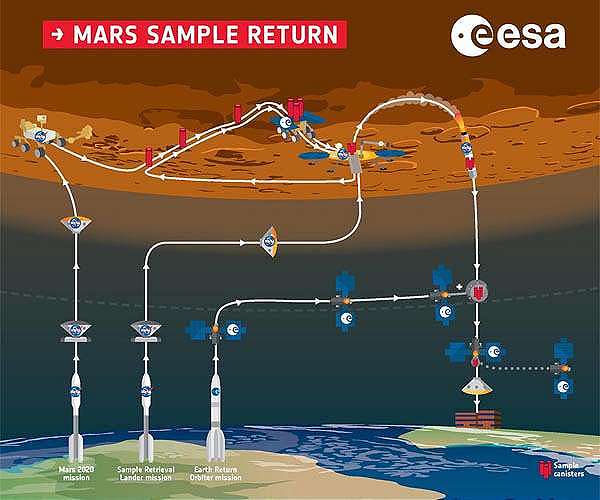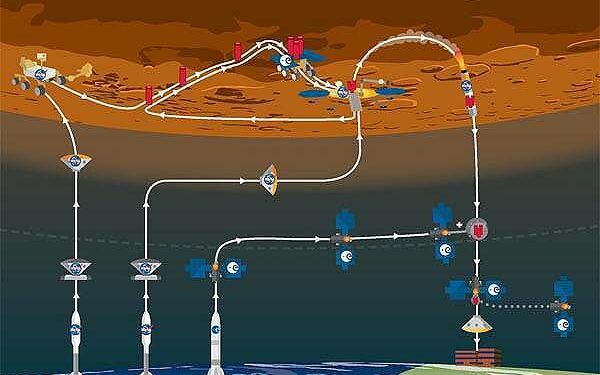
NASA’s Mars Mission: Rovers Traverse Tough Terrain Amid Budget Battles
by Amy J. Williams | Asst Professor Geology, University of Florida
Gainesville FL (SPX) Mar 13, 2024
Is or was there life on Mars? That profound question is so complex that it will not be fully answered by the two NASA rovers now exploring it.
But because of the literal groundwork the rovers are performing, scientists are finally investigating, in-depth and in unprecedented detail, the planet’s evidence for life, known as its “biosignatures.” This search is remarkably complicated, and in the case of Mars, it is spanning decades.
As a geologist, I have had the extraordinary opportunity to work on both the Curiosity and Perseverance rover missions. Yet as much as scientists are learning from them, it will take another robotic mission to figure out if Mars has ever hosted life. That mission will bring Martian rocks back to Earth for analysis. Then – hopefully – we will have an answer.
From habitable to uninhabitable
While so much remains mysterious about Mars, there is one thing I am confident about. Amid the thousands of pictures both rovers are taking, I’m quite sure no alien bears or meerkats will show up in any of them. Most scientists doubt the surface of Mars, or its near-surface, could currently sustain even single-celled organisms, much less complex forms of life.
Instead, the rovers are acting as extraterrestrial detectives, hunting for clues that life may have existed eons ago. That includes evidence of long-gone liquid surface water, life-sustaining minerals and organic molecules. To find this evidence, Curiosity and Perseverance are treading very different paths on Mars, more than 2,000 miles (3,200 kilometers) from each other.
These two rovers will help scientists answer some big questions: Did life ever exist on Mars? Could it exist today, perhaps deep under the surface? And would it be only microbial life, or is there any possibility it might be more complex?
The Mars of today is nothing like the Mars of several billion years ago. In its infancy, Mars was far more Earth-like, with a thicker atmosphere, rivers, lakes, maybe even oceans of water, and the essential elements needed for life. But this period was cut short when Mars lost its magnetic field and nearly all of its atmosphere – now only 1% as dense as the Earth’s.
The change from habitable to uninhabitable took time, perhaps hundreds of millions of years; if life ever existed on Mars, it likely died out a few billion years ago. Gradually, Mars became the cold and dry desert that it is today, with a landscape comparable to the dry valleys of Antarctica, without glaciers and plant or animal life. The average Martian temperature is minus 80 degrees Fahrenheit (minus 62 degrees Celsius), and its meager atmosphere is nearly all carbon dioxide.
Early exploration
Robotic exploration of the Martian surface began in the 1970s, when life-detection experiments on the Viking missions failed to find any conclusive evidence for life.
Sojourner, the first rover, landed in 1997 and demonstrated that a moving robot could perform experiments. In 2004, Spirit and Opportunity followed; both found evidence that liquid water once existed on the Martian surface.
The Curiosity rover landed in 2012 and began ascending Mount Sharp, the 18,000-foot-high mountain located inside Gale crater. There is a reason why NASA chose it as an exploration site: The mountain’s rock layers show a dramatic shift in climate, from one with abundant liquid water to the dry environment of today.
So far, Curiosity has found evidence in several locations of past liquid water, minerals that may provide chemical energy, and intriguingly, a variety of organic carbon molecules.
While organic carbon is not itself alive, it is a building block for all life as we know it. Does its presence mean that life once existed on Mars?
Not necessarily. Organic carbon can be abiotic – that is, unrelated to a living organism. For example, maybe the organic carbon came from a meteorite that crashed on Mars. And though the rovers carry wonderfully sophisticated instruments, they can’t definitively tell us if these organic molecules are related to past life on Mars.
But laboratories here on Earth likely can. By collecting rock and soil samples from the Martian surface, and then returning them to Earth for detailed analysis with our state-of-the-art instruments, scientists may finally have the answer to an age-old question.
Perseverance
Enter Perseverance, NASA’s newest flagship mission to Mars. For the past three years – it landed in February 2021 – Perseverance has been searching for signs of bygone microbial life in the rocks within Jezero crater, selected as the landing site because it once contained a large lake.
Perseverance is the first step of the Mars Sample Return mission, an international effort to collect Martian rock and soil for return to Earth.
The instrument suite onboard Perseverance will help the science team choose the rocks that seem to promise the most scientific return. This will be a careful process; after all, there would be only 30 seats on the ride back to Earth for these geological samples.
Budget woes
NASA’s original plan called for returning those samples to Earth by 2033. But work on the mission – now estimated to cost between US$8 billion to $11 billion – has slowed due to budget cuts and layoffs. The cuts are severe; a request for $949 million to fund the mission for fiscal 2024 was trimmed to $300 million, although efforts are underway to restore at least some of the funding.
The Mars Sample Return mission is critical to better understand the potential for life beyond Earth. The science and the technology that will enable it are both novel and expensive. But if NASA discovers life once existed on Mars – even if it’s by finding a microbe dead for a billion years – that will tell scientists that life is not a fluke one-time event that only happened on Earth, but a more common phenomenon that could occur on many planets.
That knowledge would revolutionize the way human beings see ourselves and our place in the universe. There is far more to this endeavor than just returning some rocks.
Related Links
University of Florida – Department of Geological Sciences
Mars News and Information at MarsDaily.com
Lunar Dreams and more
